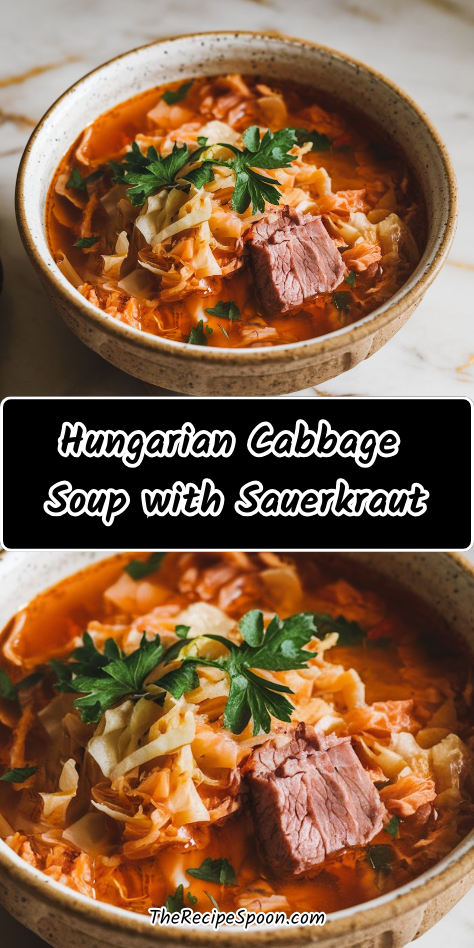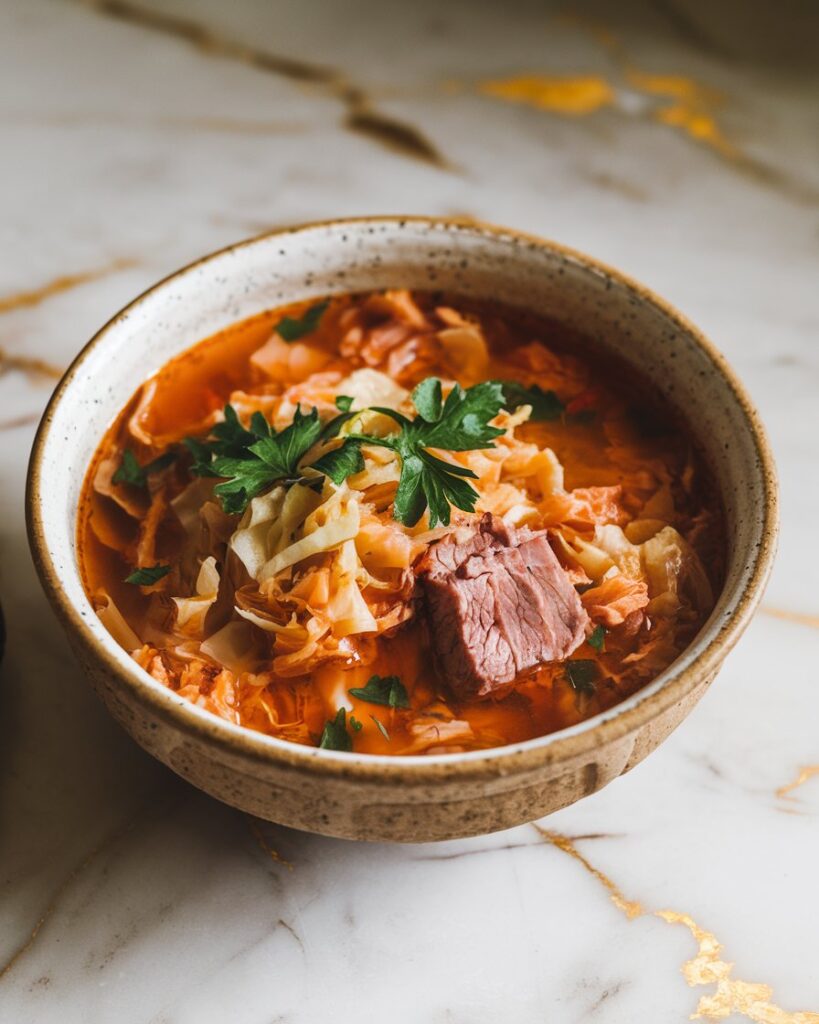I made this Hungarian cabbage soup with sauerkraut the other night, and it turned out so hearty and comforting. The mix of fresh cabbage, tangy sauerkraut, and smoky paprika gives it that bold, old-world flavor that feels both rustic and satisfying.
I love how the sauerkraut adds a little bite that balances the richness of the broth, making every spoonful warm and bright.
For me, it’s one of those soups that tastes even better the next day, and it’s perfect for chilly evenings when you just want a big bowl of something filling and flavorful.
Why You’ll Love This Recipe
This Hungarian cabbage soup is tangy, savory, and satisfying — the perfect combination of comfort and nutrition.
The sauerkraut gives the soup its signature tang, while the cabbage and pork make it hearty enough for a full meal.
Smoked paprika brings warmth and depth, turning a simple soup into something special. It’s budget-friendly, family-friendly, and a wonderful way to introduce kids to traditional flavors. Best of all, it’s a make-ahead dish that tastes even better the next day.
What You’ll Need
- 2 tablespoons vegetable oil or lard
- 1 large onion, finely chopped
- 3 garlic cloves, minced
- 1 tablespoon sweet Hungarian paprika
- 1 teaspoon smoked paprika
- 1 pound pork shoulder or pork ribs, cut into chunks
- 6 cups chicken or pork stock
- 2 cups water
- 3 cups green cabbage, shredded
- 3 cups sauerkraut, rinsed and drained (adjust to taste)
- 2 medium carrots, sliced
- 2 medium potatoes, diced
- 2 bay leaves
- 1 teaspoon caraway seeds (optional)
- 1 teaspoon salt (adjust to taste)
- ½ teaspoon black pepper
- ½ cup sour cream (for serving)
- Fresh parsley, chopped (for garnish)
Pro Tips
- Rinse sauerkraut briefly to mellow its tang but don’t over-rinse — you’ll lose the flavor.
- Use both fresh cabbage and sauerkraut for a balance of sweetness and tang.
- Pork shoulder or ribs add richness, but you can substitute smoked sausage for extra depth.
- Let the soup rest before serving — flavors meld beautifully after a few hours or overnight.
- Serve with bread — it’s perfect for soaking up the flavorful broth.
Tools Required
- Large soup pot or Dutch oven
- Wooden spoon
- Cutting board and sharp knife
- Measuring cups and spoons
- Ladle for serving
- Bowls and spoons for the table
Substitutions & Variations
- Swap pork for beef chuck or smoked sausage.
- For a vegetarian version, skip the meat and use vegetable broth. Add beans for protein.
- Adjust sourness by rinsing sauerkraut more or less depending on your preference.
- Stir in a spoonful of tomato paste for a slightly richer, sweeter broth.
- For a creamier soup, stir sour cream directly into the pot before serving.
Make-Ahead Tips
Hungarian cabbage soup is ideal for making ahead. Cook the soup fully, cool, and store in the fridge for up to 4 days.
The flavors deepen as it sits, so it often tastes better the next day. It also freezes well — portion into freezer-safe containers and store for up to 3 months. Thaw overnight in the fridge and reheat gently.
Instructions
1. Sauté onion and garlic
Heat oil or lard in a large pot over medium heat. Add chopped onion and cook until soft, about 5 minutes. Stir in garlic and cook for another minute.
2. Add paprika
Sprinkle in sweet and smoked paprika. Stir quickly to coat the onions — this step unlocks the paprika’s full flavor.
3. Brown the pork
Add pork chunks to the pot and brown on all sides, about 5–7 minutes.
4. Add stock and simmer
Pour in stock and water. Add bay leaves and caraway seeds if using. Bring to a boil, then reduce to a gentle simmer. Cover and cook for 45 minutes, until pork is tender.
5. Add vegetables
Stir in cabbage, sauerkraut, carrots, and potatoes. Simmer uncovered for another 30 minutes, until vegetables are tender and the soup is flavorful.
6. Adjust seasoning
Taste and add salt and black pepper as needed.
7. Serve
Ladle hot soup into bowls. Garnish with fresh parsley and a dollop of sour cream. Serve with crusty bread.
Serving Suggestions
This soup pairs wonderfully with a slice of rustic bread or rye bread to soak up the tangy broth.
For a fuller meal, serve alongside a light salad or pickles. If you want to keep it traditional, pair with Hungarian potato pancakes or even pierogi. For family dinners, keep sour cream on the side so everyone can stir in as much as they like.
Leftovers & Storage
Store leftovers in airtight containers in the refrigerator for up to 4 days. Reheat gently on the stove over medium-low heat, adding a splash of broth if the soup has thickened.
For longer storage, freeze portions in containers for up to 3 months. This soup tastes even better reheated, so don’t be afraid to make a big batch.
Nutrition & Benefits
Hungarian cabbage soup is nourishing as well as delicious. Cabbage and sauerkraut provide vitamin C, fiber, and probiotics for gut health.
Pork adds protein and richness, while carrots and potatoes bring natural sweetness and extra nutrients.
Paprika not only adds flavor but also contains antioxidants. It’s a wholesome dish that warms the body and supports wellness during colder months.
Recipe FAQ
1. Can I use only sauerkraut and skip the fresh cabbage?
Yes, but the soup will be tangier. Using both creates balance.
2. Is this soup spicy?
No, Hungarian paprika is sweet, not hot. Add hot paprika or chili flakes if you want heat.
3. Can I make this in a slow cooker?
Yes, sauté onions and pork first, then transfer everything to a slow cooker and cook on low for 6–8 hours.
4. Do I have to add sour cream?
It’s optional, but traditional. It adds creaminess and balances the tang.
5. How do I thicken the soup?
Mash some of the potatoes in the pot or add a tablespoon of flour when sautéing onions.
A Bowl of Comfort to Share
This Hungarian cabbage soup with sauerkraut is more than just a meal — it’s tradition simmered in a pot.
With its tangy, smoky broth and hearty mix of pork and vegetables, it’s the kind of dish that brings comfort on the coldest days. It’s also versatile, easy to make ahead, and budget-friendly.
So the next time you’re looking for a recipe that warms both the body and the heart, give this one a try. I’d love to hear how it turned out — did you keep it classic, or add your own twist? Share your version and keep this hearty tradition alive.





